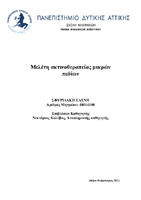| dc.contributor.advisor | Kalyvas, Nektarios | |
| dc.contributor.author | Σφυριδάκη, Ελένη | |
| dc.date.accessioned | 2021-03-02T16:40:50Z | |
| dc.date.available | 2021-03-02T16:40:50Z | |
| dc.date.issued | 2021-02-25 | |
| dc.identifier.uri | https://polynoe.lib.uniwa.gr/xmlui/handle/11400/256 | |
| dc.identifier.uri | http://dx.doi.org/10.26265/polynoe-107 | |
| dc.description.abstract | Σκοπός: Κύριος σκοπός είναι η διερεύνηση και ανάλυση των τεχνικών ακτινοθεραπείας για μικρά πεδία, καθώς και η αναλυτική παράθεση των μηχανημάτων που υποστηρίζουν τη μέθοδο αυτή. Επίσης, έγινε αναζήτηση του βέλτιστου υλικού θωράκισης και συνδυασμού παραμέτρων για μεταφορά ηλεκτρονίων και φωτονίων σε στόχο ιστού μέσω προσομοίωσης ακτινοθεραπευτικής διάταξης.
Μέθοδος και Υλικά: Χρησιμοποιήθηκε κώδικας PENELOPE, ένα έτοιμο ελεύθερο σύστημα κώδικα Monte Carlo. Το σύστημα αποτελείται από κυλινδρικό μακρύ κατευθυντήρα οπής διαμέτρου 4cm. Ως πηγή ακτινοβόλησης χρησιμοποιήθηκε μονοενεργειακή πηγή φωτονίων γ σε απόσταση 100cm από τον ιστό εξέτασης και εντός του κατευθυντήρα Τα υλικά θωράκισης ήταν Σίδηρος (Fe), Μόλυβδος (Pb) και Βολφράμιο (W) σε πάχη 1cm, 3cm και 5cm, και οι ενέργειες ακτινοβόλησης ήταν 2MeV, 4MeV, 6MeV, 8MeV και 10MeV. Η κάθε προσομοίωση είχε χρόνο διάρκειας 900sec (15min) ή 107 ιστορίες φωτονίων. Τα αποτελέσματα εξήχθησαν από διαγράμματα χωρικής κατανομής δόσης, δισδιάστατης και τρισδιάστατης, και από την κυλινδρική κατανομή δόσης. Η χωρική κατανομή διερευνήθηκε για 10cm βάθος ιστού και η κυλινδρική κατανομή για 15cm βάθος ιστού, με βήμα 1cm.
Αποτελέσματα: Ένα μικρό ποσοστό ακτινοβολίας είναι συνεχώς παρόν πολύ κοντά στα όρια στης ακτινοβολούμενης επιφάνειας, αλλά έξω από αυτά, το οποίο αυξάνεται όσο αυξάνεται και η ενέργεια ακτινοβόλησης. Η θωράκιση Μολύβδου και Βολφραμίου είναι γενικά πιο ισχυρή σε σχέση μ’ εκείνη του Σιδήρου. Επίσης, παρατηρούμε μια αύξηση της ακτινοβολίας μακριά απ’ την ακτινοβολούμενη περιοχή (>5cm) στη θωράκιση Σιδήρου.
Συμπεράσματα: Η θωράκιση Μολύβδου και Βολφραμίου δίνουν τα καλύτερα αποτελέσματα απορρόφησης δόσης σε σχέση με τη θωράκιση Σιδήρου. Οι δύο βέλτιστοι συνδυασμοί παραμέτρων είναι 5cm θωράκισης Μολύβδου με ενέργεια ακτινοβόλησης 4MeV και 5cm θωράκισης Βολφραμίου με ενέργεια ακτινοβόλησης 8MeV. | el |
| dc.format.extent | 101 | el |
| dc.language.iso | el | el |
| dc.publisher | Πανεπιστήμιο Δυτικής Αττικής | el |
| dc.rights | Αναφορά Δημιουργού - Μη Εμπορική Χρήση - Παρόμοια Διανομή 4.0 Διεθνές | * |
| dc.rights | Attribution-NonCommercial-NoDerivatives 4.0 Διεθνές | * |
| dc.rights.uri | http://creativecommons.org/licenses/by-nc-nd/4.0/ | * |
| dc.subject | Aκτινοθεραπεία | el |
| dc.subject | Μικρά πεδία | el |
| dc.subject | Monte Carlo | el |
| dc.subject | PENELOPE | el |
| dc.subject | Yλικά κατευθυντήρα | el |
| dc.title | Μελέτη ακτινοθεραπείας μικρών πεδίων | el |
| dc.title.alternative | A study of small radiotherapy fields | el |
| dc.type | Διπλωματική εργασία | el |
| dc.contributor.committee | Σκουρολιάκου, Αικατερίνη | |
| dc.contributor.committee | Liaparinos, Panagiotis | |
| dc.contributor.faculty | Σχολή Μηχανικών | el |
| dc.contributor.department | Τμήμα Μηχανικών Βιοϊατρικής | el |
| dc.description.abstracttranslated | Scope: The main purpose is the investigation and analysis of radiotherapy techniques for small fields, as well as the detailed list of devices that support this method. Also, the optimal shielding material and combination of parameters for electrons and photons transfer to a tissue target through a simulation of a radiotherapy device was searched..
Methods and Materials: PENELOPE code was used, a ready-made free Monte Carlo code system. The system consists of a cylindrical long hole collimator with 4cm diameter. A single energy source of γ photons was used as the irradiation source at a distance of 100cm from the test tissue and inside the collimator. The shielding materials were Iron (Fe), Lead (Pb) and Tungsten (W) in thicknesses of 1cm, 3cm and 5cm 2MeV, 4MeV, 6MeV, 8MeV and 10MeV. Each simulation had a duration of 900sec (15min) or 107 photon stories. The results were extracted from spatial dose distribution diagrams, two- and three-dimensional, and from the cylindrical dose distribution. The spatial distribution was investigated for 10cm tissue depth, and the cylindrical distribution for 15cm tissue depth, with 1cm step.
Results: A small percentage of radiation is constantly present very close to the limits of the irradiated surface, but outside them, which increases as the irradiation energy increases. Lead and Tungsten shielding is generally stronger than Iron shielding. We also observe an increase in radiation away from the irradiated area (> 5cm) in the Iron shield.
Conclusion: Lead and Tungsten shielding give the best dose absorption results compared to Iron shielding. The two optimal parameter combinations are 5cm Lead shield with 4MeV radiation energy and 5cm Tungsten shield with 8MeV radiation energy. | el |


